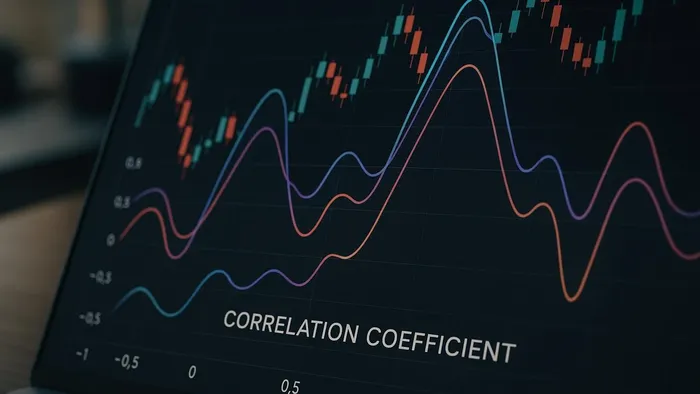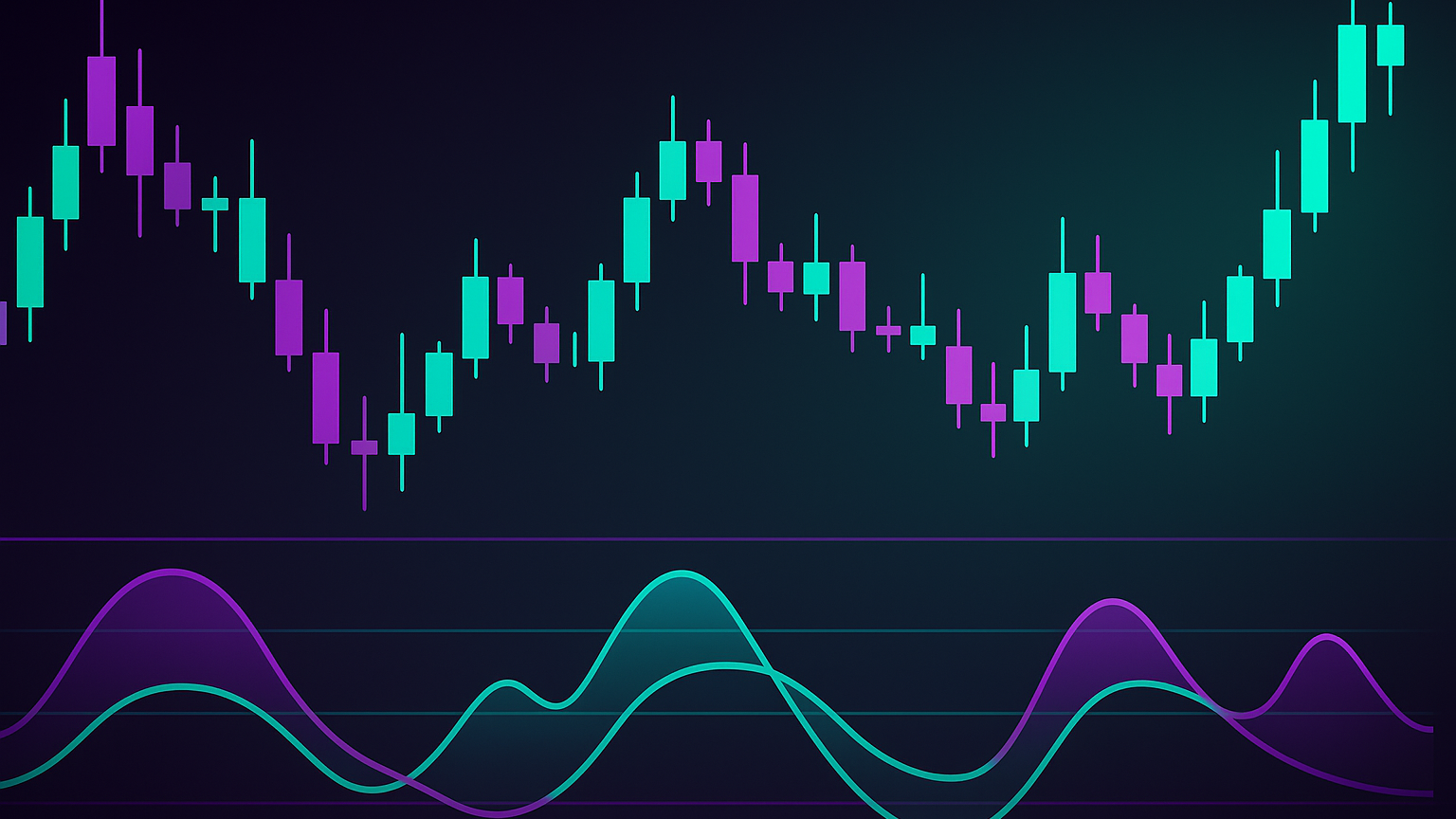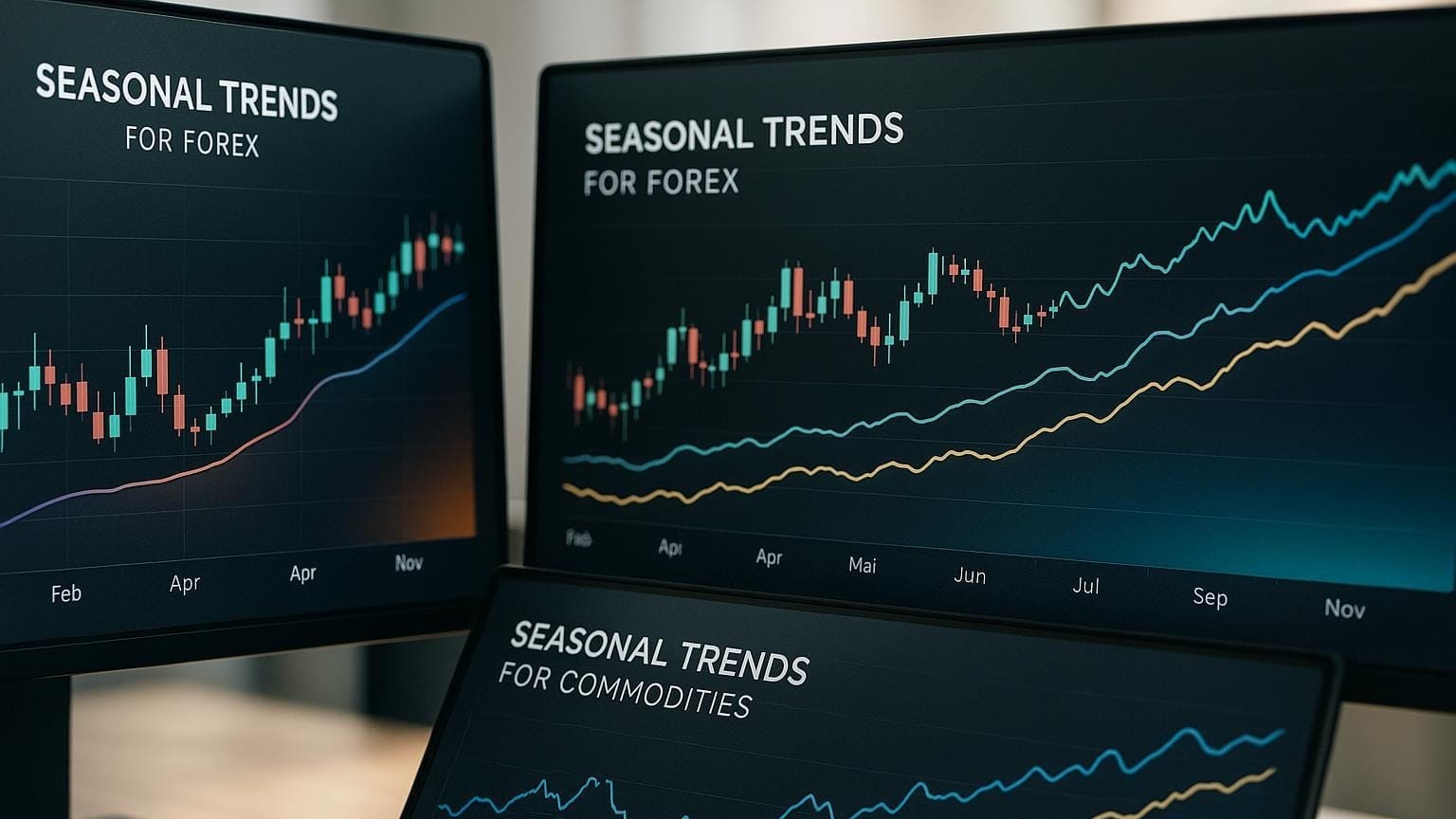Explore the correlation coefficient indicator to understand asset relationships, manage risks, and refine trading strategies for better portfolio performance.
The Correlation Coefficient Indicator is a statistical measure that shows how two financial assets move in relation to one another. It assigns a value between -1 and +1 to indicate the strength and direction of their relationship. For a plain-English primer, see this overview of the correlation coefficient.
- +1: Assets move perfectly in the same direction.
- 0: No linear relationship.
- -1: Assets move perfectly in opposite directions.
Traders use this data to manage risk, diversify portfolios, and identify market trends. For example, pairing assets with low or negative correlations can help reduce portfolio risk. However, correlations can change during volatile markets, making regular analysis critical.
Key Takeaways
- How to Calculate: Platforms automate this by analyzing historical price data.
- Interpreting Values: Strong positive (>0.7) or negative (<-0.3) correlations are most actionable.
- Timeframes: Short-term (14–21 days) for active traders; long-term (50–200 days) for investors.
- Limitations: Only measures linear relationships and can be skewed by market shifts or small datasets.
LuxAlgo provides correlation-focused tools on TradingView, including heatmaps and AI backtesting, helping traders refine strategies and manage risks effectively.
How to Calculate and Interpret the Correlation Coefficient
The Calculation Process
To calculate the correlation coefficient, you’ll need historical price data for two assets over a specific timeframe. This metric helps measure how closely the price movements of these assets align.
The key inputs are the closing prices of both assets over your chosen period. For reliable results, traders typically use data spanning 20 to 100 periods, with larger datasets offering more accurate insights. Luckily, most trading platforms handle these calculations automatically, so you can focus on interpreting the results and planning your strategy.
Here’s how the calculation works: the formula standardizes each asset’s price movements relative to its average, then determines how often these changes occur in the same direction. It divides the covariance of the two assets by the product of their standard deviations. Modern platforms simplify this process, instantly providing correlation values between -1 and +1 for easy interpretation. Many traders also track rolling correlations to see how relationships evolve through time.
Reading Correlation Values
Understanding the meaning of correlation values is essential for applying them to trading decisions. Here’s a quick breakdown:
- Above 0.7: Strong positive correlation — assets tend to move together.
- 0.3 to 0.7: Moderate positive correlation — some alignment in price movements.
- Below -0.3: Negative correlation — assets often move in opposite directions.
- Near 0: Little to no correlation — price movements are largely independent.
For example, a correlation of 0.85 indicates that two assets move in sync, which could limit diversification benefits. On the other hand, a correlation of -0.6 suggests the assets frequently move in opposite directions, potentially providing a natural hedge.
It’s important to note that market conditions can significantly affect correlations. During periods of high volatility or market stress, correlations often increase as assets move together — a common flight-to-quality dynamic. This can undermine diversification strategies when they’re needed most.
Timeframes and Settings for Analysis
Once you know how to interpret correlation values, the next step is selecting the right timeframe for your analysis. Different timeframes yield different results, so your choice should align with your trading style and objectives.
- Short-term traders often use 14 to 21-day periods to analyze recent relationships.
- Long-term investors may prefer 50 to 200-day periods to capture broader trends.
- Daily timeframes are ideal for swing trading, while weekly correlations highlight longer-term patterns. Monthly correlations reveal fundamental relationships but may be too slow for active trading.
The lookback period — how many data points the calculation uses — also plays a role. Shorter periods (10–20 days) are more sensitive to recent changes but can produce volatile readings. Longer periods (50–100 days) smooth out fluctuations, offering more stable insights but potentially lagging behind market shifts.
Many traders rely on rolling correlations, which update continuously by replacing the oldest data with the newest. This keeps the analysis current while maintaining a consistent sample size. Monitoring multiple timeframes can provide both short-term tactical insights and long-term strategic perspectives.
Finally, consider adjusting your settings based on market volatility. In calmer markets, shorter lookback periods can help spot emerging trends. In volatile conditions, longer periods may give more stable readings and reduce noise from temporary price swings. These adjustments ensure your correlation analysis is tailored to your trading goals, whether for precise entry points or broader portfolio strategies.
Practical Applications in Trading Strategies
Improving Portfolio Diversification
Building a well-diversified portfolio starts with understanding how different assets move in relation to one another. The correlation coefficient is a key tool traders use to pinpoint assets that are less likely to decline at the same time during market downturns. For background on diversification mechanics, see the SEC Investor Bulletin on diversification.
Traders typically aim for assets with low or negative correlations to spread risk effectively. During periods of market stress, stock correlations often rise, which can undermine diversification. In such cases, traditional safe havens like U.S. Treasury securities can offer protection, as they often move independently of equities.
Blending sectors with distinct economic drivers — such as technology and utilities — can also help balance a portfolio. These sectors tend to respond differently to economic shifts. Additionally, including assets like emerging-market bonds or real estate investment trusts (REITs) can add another layer of diversification since their performance patterns often differ from large-cap domestic stocks.
Since market conditions are constantly evolving, regular portfolio reviews are crucial. This approach not only supports diversification but also helps traders stay ahead of broader market trends.
Market Trend Identification and Asset Co-Movement
Correlation analysis does more than just enhance diversification — it also sheds light on larger market trends. For instance, rising correlations across multiple sectors can indicate shifts in market sentiment or even signal emerging systemic risks.
In stable markets, moderate correlations can support strategies like sector rotation, where traders move between sectors to capitalize on varying performance cycles. On the other hand, a sharp increase in correlations across different sectors may point to growing risk aversion among investors.
For international traders, shifts in currency correlations can reveal economic or political uncertainties. Similarly, changes in commodity price movements often reflect inflation expectations or transitions in economic cycles. By keeping a close eye on these patterns, traders can uncover new opportunities and fine-tune their strategies.
Risk Management with Correlation
Correlation analysis is also a powerful tool for managing risk. It helps traders understand how different positions in a portfolio might move in relation to each other, reducing the chance of overexposure to the same market risks — even when the portfolio appears diversified.
By using correlations to guide position sizing, traders can adjust their exposure to assets that tend to react similarly to market events. This is especially helpful during periods of heightened correlation, where traditional stop-loss strategies might trigger across multiple positions simultaneously. Modifying stop-loss levels to account for expected co-movements can lead to smoother risk management (see the NYSE overview of stop orders).
Hedging strategies also benefit from identifying asset pairs that typically move in opposite directions. However, it’s important to remember that these relationships can change under stress. Pairs trading, which relies on stable correlation patterns, offers opportunities when temporary divergences occur (primer on pairs trading).
Visual tools like portfolio heat maps can highlight areas where risk may be overly concentrated due to correlated exposures. Additionally, being aware of correlation shifts during key trading sessions — such as the market open or close — can help traders adjust their risk exposure in real time.
Correlation Coefficient Indicator on TradingView
Using LuxAlgo for Correlation Analysis

LuxAlgo provides specialized indicators for detecting and monitoring correlation. Two popular free tools in the Library are Historical Correlation and Correlation Clusters. Historical Correlation lets you compare up to 10 user-defined tickers from a specified start date to visualize how relationships have strengthened or weakened over time. Correlation Clusters organizes tickers by similarity to a reference symbol so you can quickly spot groups that move together or independently (see the script page on TradingView here).
Important: LuxAlgo’s Premium toolkits don’t calculate correlation themselves. They’re best used alongside correlation tools to plan entries, exits, and risk. If you want Premium features to help detect correlation opportunities across markets, use the LuxAlgo Screeners — they scan tickers using Premium logic and can be paired with Historical Correlation or Clusters to find execution candidates. Learn more about screeners on the features page and the S&O Screener documentation.
AI Backtesting Assistant for Strategy Optimization
The AI Backtesting Assistant helps transform correlation insights into complete strategies by searching and evaluating millions of backtested setups. Start at the main page here and see the introduction and fetching strategies guides for workflow tips.
It also provides real-time adjustments and risk evaluations by assessing how changes in correlation impact strategy performance. For automated notifications during tests, review Backtesting System Alerts.
Benefits of Using LuxAlgo for Correlation Analysis
| LuxAlgo Tool/Feature | Benefit for Identifying Asset Co-Movement | Benefit for Risk Management |
|---|---|---|
| Correlation Clusters | Groups assets by similarity to a reference ticker, highlighting correlated and uncorrelated sets | Supports diversification by pinpointing uncorrelated assets to minimize overexposure |
| Historical Correlation | Shows how correlations change over time and across tickers | Helps manage long-term risks by tracking relationship shifts |
| Correlation Heatmaps | Visualizes multi-asset relationships with color-coded strengths | Reveals concentration risk across a portfolio |
| LuxAlgo Screeners (Premium) | Surface tickers that match Premium conditions to pair with correlation tools | Faster execution planning once correlation candidates are found |
| AI Backtesting Assistant | Turns correlation hypotheses into tested strategies | Evaluates risk/return as correlation regimes change |
LuxAlgo’s tools offer several advantages. Features like dynamic heatmaps and multi-timeframe analysis let you examine relationships across intraday to longer horizons. For scenario work alongside correlation, see the Monte Carlo Shuffled Projection. Automated alerts keep you informed of regime changes without constant monitoring.
Advantages and Limitations of the Correlation Coefficient Indicator
Advantages of the Correlation Coefficient Indicator
The correlation coefficient indicator offers traders and portfolio managers a way to analyze asset relationships with clear, numerical precision. By providing exact values between -1.00 and +1.00, it removes much of the guesswork from assessing how assets interact. This precision makes it a valuable measure for decision-making in financial markets.
One of its key strengths lies in risk management. By identifying assets with low or negative correlations, traders can build portfolios that are better equipped to handle market volatility. For example, combining assets with mildly negative correlations can help stabilize performance during turbulent periods.
The indicator also helps uncover hidden relationships between seemingly unrelated assets. This can be particularly useful during market crises, when assets that traditionally had low correlations suddenly start moving in sync. Regular monitoring of correlations can help traders stay ahead of such shifts.
Another advantage is its ability to signal major market changes. For instance, if the usual negative correlation between the U.S. dollar and commodities starts to weaken or reverse, it might indicate shifting economic conditions. Traders who recognize these changes early can position themselves to take advantage of emerging trends.
Additionally, the correlation coefficient supports pairs-trading approaches by identifying assets with strong positive correlations. This is especially effective with sector ETFs or related currency pairs, where deviations from historical correlations can present opportunities.
Limitations and Considerations
While the correlation coefficient is powerful, it only measures linear relationships. If two assets have a non-linear or cyclical connection, the value may fail to capture it, even if the assets influence each other in significant ways.
Another issue is that correlations can vary depending on the timeframe analyzed. For example, a 30-day correlation between tech stocks and bonds might show +0.20, but over 250 days, the correlation could shift to -0.40. Relying on a single timeframe risks drawing incorrect conclusions.
The reliability of correlation data also depends heavily on the sample size. Short-term correlations based on limited data points are more likely to be skewed by random market noise. For instance, a correlation calculated over just 10 trading days is far less meaningful than one based on 100 days of data.
Structural changes in the market can also undermine effectiveness. Major shifts, such as new regulations or economic events, can render historical correlations less relevant. Yet, the indicator continues to rely on past data, which can mislead traders if not updated.
Best Practices for Using the Indicator
To address these limitations, consider the following best practices:
- Analyze multiple timeframes: Review correlations across daily, weekly, and monthly intervals to understand both short-term movements and long-term trends.
- Recalibrate regularly: Update correlation calculations frequently, especially during periods of heightened market volatility. Weekly reviews help ensure your analysis reflects current conditions.
- Combine with other indicators: Use correlation alongside momentum, volume, and fundamentals for a more complete view. When these tools align, signals tend to be more reliable.
- Check statistical significance: Base analysis on enough observations — at least ~30 for short-term trends and 100+ for long-term patterns. Weak correlations (between -0.30 and +0.30) often lack predictive value.
- Diversify and manage risk: Limit position sizes based on correlation strength, use stop-losses even for highly correlated pairs, and diversify across different correlation groups.
- Document patterns over time: Keep records of correlation changes and context. This history can reveal recurring patterns and improve future analysis.
Conclusion and Key Takeaways
The correlation coefficient is a powerful resource for understanding how financial assets move in relation to one another. By delivering precise values between -1.00 and +1.00, it reduces uncertainty in portfolio construction and risk management. Whether you’re working to build a diversified portfolio, uncover pairs-trading opportunities, or monitor market trends, this measure provides the clarity needed to make well-informed decisions.
While it shines in measuring linear relationships, it has blind spots. It doesn’t account for non-linear dynamics and can be influenced by sudden market changes. Traders address these challenges by analyzing multiple timeframes, recalibrating regularly, and using additional technical indicators for context.
Understanding how assets interact is central to effective risk management. By identifying these relationships, you can build a portfolio better equipped for volatility. LuxAlgo’s correlation tools, screeners, and AI Backtesting can help convert those insights into actionable strategies.
For best results, pair correlation with momentum, volume, and fundamentals. As markets evolve, regularly monitor relationships and adapt. With the right approach, correlation becomes an essential ally in navigating today’s complex landscape.
FAQs
How do changing market conditions impact the accuracy of correlation coefficient analysis?
Market conditions are never static, and shifts like rising volatility or economic stress can throw a wrench into correlation analysis. For instance, during periods of high volatility, asset correlations often rise. This can give a false sense of security, leading traders to overestimate diversification benefits or misunderstand how assets are truly connected.
Another challenge is that correlations aren’t set in stone — they can change rapidly as markets evolve. Because of this, relying solely on historical correlation data can be risky when trying to predict future trends. To avoid missteps, stay flexible and update your analysis to reflect the current market environment.
How can I use the correlation coefficient indicator to effectively manage portfolio risk?
To manage portfolio risk effectively with the correlation coefficient, diversify into assets with low or negative correlations. This can reduce overall volatility. It’s also important to monitor how correlation values change over time so you can adjust exposures as conditions evolve.
On the flip side, spotting assets with high correlations can help you avoid concentrating in similar risks. Used strategically, correlation improves position sizing, hedging, and execution timing.
How does LuxAlgo's AI Backtesting Assistant help traders use correlation data to improve their strategies?
LuxAlgo's AI Backtesting Assistant streamlines the process of analyzing correlation-driven ideas across assets and timeframes. By rapidly testing and iterating, it helps uncover patterns and opportunities that might be missed with manual analysis.
Using AI, the platform pinpoints subtle connections between assets and evaluates how changes in correlation affect performance. This empowers traders to refine strategies and make more informed decisions, with clear, data-backed insights.
References
LuxAlgo
- Correlation Coefficient Indicator (Correlation Tracker)
- Historical Price Projection
- Multi-Timeframe Market Formation
- Market Sentiment (Technicals)
- Sessions
- Historical Correlation
- Correlation Clusters
- AI Backtesting Assistant — Main Page
- AI Backtesting Assistant — Introduction
- AI Backtesting — Fetching Strategies
- Backtesting System Alerts
- AI Backtesting Assistant — Breakdown
- LuxAlgo Screeners (Features)
- S&O Screener — Introduction
- Monte Carlo Shuffled Projection








